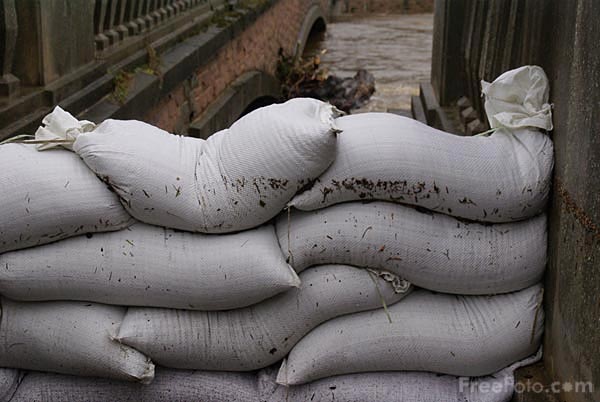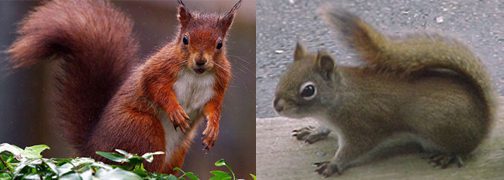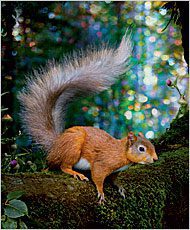Research Journal
-
April 16, 2009
“Inter Sylvas et Flumina Habitans”
Morpeth,
Living amid the woods and waters…A Coaching Stop on the London-Edinburgh route which crossed the ‘moors-path’
Alternatively called the `Murder Path’ from the times of the border reivers (basically robber barons) (1400-1600). Somewhat akin to the Wild West.

1500's woodcut from John Skelton's 'Ballade of the Scottyshe Kynge' Unwilling host of the 2008 floods 
-
April 12, 2009
Charismatic megafauna: you can’t live without ’em.
“Giant pandas are ‘charismatic megafauna,’ a category that includes whales and other sea mammals, salmon and other inspirational fish, eagles and other flashy raptors. In each instance, the creatures help spotlight the hundreds of humbler but equally endangered species: the black-spored quillwort, the longhorn fairy shrimp.”
—”Birth and Rebirth,” USA Today, August 23, 1999Usually thought of as poster children for environmental issues, they’re often super cuddly or super scary. Or both (like polar bears).
I’d add to this list:
Jellyfish (alien death squad)
Squirrels (mischievous urban representatives)But people look at me funny if I start geeking out about plankton or mycelial networks (although the latter can get pretty trippy). If we could spin them right, they’d be seen for the superheroes they are.
More on the Uncharismatic Poster Children:

Mycelium Running:
How Mushrooms Can Help Save the Worldand Paul Stamets’ talk from TED:
-
April 12, 2009
Jellyfish/Plankton/Plastics tangle continues
Tags:Animals that eat jellyfish also eat plastic bags
Animals that eat plankton or fish eggs also eat plastic pellets
Animals that eat fish also eat plastic.
Nurdles: Before – During – After (photos from flickr) MSNBC posted a story on April 9, about leatherback turtles’ diet of plastic bags.
A new study looked at necropsy reports of more than 400 leatherbacks that have died since 1885 and found plastic in the digestive systems of more than a third of the animals.
Leatherback turtles are critically endangered and highly charismatic creatures. They are big, weighing 1,000 pounds or more, with shells that can measure more than 6 feet across. These peaceful creatures have had the same basic body plan for 150 million years.
Leatherbacks are also popular for what they eat: namely, large quantities of jellyfish. The problem is that plastic bags look a lot like jellyfish, and plastic often ends up in the oceans, piling up in areas where currents — and turtles — converge.
Plastic can block a turtle’s gut, causing bloating, interfering with digestion, and leading to a slow, painful death. “I can’t imagine it’s very comfortable,” he said. “Their guts weren’t designed to digest plastic.”
There are vast fields of trash floating in the world’s oceans, Sasso added. And leatherback turtles travel thousands of miles each year, giving them even more opportunities to come in contact with it.
“This is an animal that has survived many extinction events,” James said, “And now it’s got all these anthropogenic hazards to face.”
And there’ve been a spate of publications on the amount of plastic – both nurdles, which are plankton or fish-egg -sized industrial plastic pellets from manufacturing shopping bags, dollar-store articles, and construction material that ends up in the oceans, and consumer plastic (bottles, bags, buckets, etc), which breaks down into ever-smaller pieces but does not completely degrade. This stat is from 2001:
There is now six times more plastic debris in part of the North Pacific Ocean than zooplankton, the populous animal plankton that forms the base of the aquatic food chain.
– C. J. Moore, S. L. Moore, M. K. Leecaster and S. B. Weisberg (December 2001). “A Comparison of Plastic and Plankton in the North Pacific Central Gyre”, Marine Pollution Bulletin 42)Granted this statistic has been rejected because it only reflects an analysis made in the Pacific Gyre, a confluence of currents and thus a concentration of the contents of what’s carried on them; but even so, the volume of plastics is not decreasing. Some solutions: don’t take plastic bags, get refillable canteens for water. Reconsider the purchase of synthetics which may discharge plastics on the manufacturing process. Consider what else you can do with the plastics you are about to throw in the garbage.
If fish are eating plastic nurdles, then so are we if we eat fish.
Here’s more nurdle info:
http://www.nurdlesaretheenemy.com/http://theurbancoaster.com/index.php?option=com_content&view=article&id=179&Itemid=92&lang=en
http://ewasteguide.info/more-plastic-plankto
-
April 12, 2009
Jellyfish Gone Wild
Tags:It’s spring break the oceans over.

Sign on beach in Australia. Credit: Dr. Jamie Seymour, James Cook University Australia’s beaches regularly host many types of toxic gelatinous animals, including the notorious Portuguese Man-of-War and Chironex fleckeri, a type of box jellyfish that is the world’s most venomous animal; a Chironex can kill a person in under three minutes.
In addition, some species of potentially deadly box jellyfish known as Irukandji jellyfish are currently increasing in number in Australian waters, possibly because of climate change. These peanut-sized jellyfish are small enough to slip through nets that protect Australia’s beaches from their larger Chironex cousins.
–The National Science FoundationThe National Science Foundation has published an extensive report on the Dead Zone/jellyfish connections, but I thought I’d quote the article’s description of the upsides of jellyfish:
ECOLOGICAL ROLES OF JELLYFISH
Plying the world’s oceans for over 500 million years, gelatinous creatures have influenced marine communities almost as long as marine communities have existed.
As prey, gelatinous creatures are eaten by seabirds, pink salmon, sun fish, turtles and other gelatinous creatures. (Animals that eat jellyfish are not impacted by their stings.) As predators, gelatinous creatures eat fish eggs and larvae, invertebrates, small, floating creatures called zooplankton and other gelatinous creatures.
Scientists are continuing to identify new ecological services provided by jellyfish. For example, recent studies show that the tentacles dangling from the Bering Sea’s large jellyfish provide hiding places for young pollock that are pursued by other predators but have grown too big for the jellyfish to eat.
…This last upside, while über poetic (Jellyfish-as-beaded-curtain; Quick! let’s duck out of harm’s way and hide in this undulating petticoat) does make me wonder if the upsides are outweighed by an anvil-load of problems.
-
-
April 12, 2009
Jellyfish Fantasy Hall or The Rise of Slime?
Tags:Enter the Jellyfish Fantasy Hall at Enoshima Aquarium south of Tokyo and you will find yourself surrounded by dazzling swarms of gently pulsating creatures… Jellyfish, which have inhabited the world’s oceans in one form or another for over one billion years, come in a dizzying array of shapes, sizes and colors.
– from Pink Tentacle
It’s an interesting time to be celebrating these Ophelia-esque critters who mark so many things, from alien beauty to changing oceans (beautiful horror/reality in this LA Times editorial on “Altered Oceans“). It’s not surprising to find that the phrases “The Rise of Slime” or “Invasion of the The Jellyfish Blooms” read like science fiction.
Rising temperatures in the oceans are a root cause of these blooms, attributable to ocean acidity levels, toxic sewage and animal waste runoffs, fertilizer dumping (fish or land farming), overfishing and other pollutants. “The Rise of Slime,” a return to primordial oceans, is one descriptor of a Dead Zone, a drastic reduction in the ocean’s oxygen levels. Jellyfish are one of the only animals who can thrive in this climate.
The EPOCA/Ocean Acidification blog sums it up nice and heavy:
“They are calling it “the other CO2 problem”. Its victim is not the polar bear spectacularly marooned on a melting ice floe, or an eagle driven out of its range, nor even a French pensioner dying of heatstroke. What we have to mourn are tiny marine organisms dissolving in acidified water.
In fact we need to do rather more than just mourn them. We need to dive in and save them. Suffering plankton may not have quite the same cachet as a 700-kilo seal-eating mammal, but their message is no less apocalyptic. What they tell us is that the chemistry of the oceans is changing, and that, unless we act decisively, the limitless abundance of the sea within a very few decades will degrade into a useless tidal desert.”

Nomura bloom, in the expanding "Dead Zone" Link to some info on the Gulf of Mexico Dead Zone, currently the largest in the world.
Link to more general information about Dead Zones and the jellyfish connection
-
-
-
April 12, 2009
Squirrel Facts (Reds VS Grays)

In an effort to save the native Red Squirrel, the invasive Gray Squirrel in the UK been subject to a holocaust (esp in Northumbria, the last stronghold of the reds): Over 20,000 Gray Squirrels are Culled. Gray Squirrels were brought over from America in the early 19th century “to amuse the rich;” now they’ve gotten out of hand, and the native Red (arguably the cuter, daintier and foxier of the two species) is close to extinction.
There was a Channel 4 doc about the battle.
Chicago Sun Times summed up the problem pithily:
“…consider now the British red squirrel, a vibrant, cheeky little creature whose scarlet coat simply glows. The sad truth of the matter is that the big, pushy American gray squirrel is taking over and causing marked species decline.“The red squirrel is native to Britain, but its future is increasingly uncertain as the introduced American gray squirrel expands its range across the mainland. There are estimated to be only 140,000 red squirrels left in Britain, with over 2.5 million grays. The Forestry Commission is working with partners in projects across Britain to develop a long-term conservation strategy that deters grays and encourages reds.”
The red squirrel may be an English icon, just like a red fox, but it is dying out here in Great Britain, as the above Forestry Commission report makes clear. This is hardly a new phenomenon. I think of Bill Bryson’s excellent Australia travel book, In a Sunburnt Country, which documents case after case of species annihilation caused by the introduction of Western plants and animals.
This time, though, the little red British squirrel is at the mercy of the behemoth American gray. Of course the culture critics can make all sorts of fun metaphors with that one. But I see this phenomenon as more of a scientific fact of life, albeit one that I hope we can alter. So I cheer on the underdog red squirrel, especially the cute ones that scampered under our lodge window in the Scottish Highlands, snatching up the peanuts we put out for them and running up the nearby silver birch to crack into the shells as we cheered from within.” – http://blogs.suntimes.com/fosnight/2008/02/red_squirrel_versus_grey_squir.html
A choice commentator elsewhere called the grays “foreign interlopers, not even European.’
Rife with potential analogies and clear subtexts, the (American) Gray Squirrel is a virus carrier, to which it is immune. With its arsenal of squirrelpox and its talent for landgrabbing, it has succeeded in exterminating most of the UK Reds.So, the Gray Squirrel is being culled.
In Northern England, there is a force called the Red Squirrel Protection Unit, founded by the 6th Baron Redesdale of Northumberland (The Baron has a lengthy profile for his squirrely patriotism in the New York Times, 2007).
I found out that at least his co-founder, the verminator Paul Parker eats the culled Grays.
‘We developed what we called our killing strategy. Hit them in the woods. Dipton Woods: we took 2,000 out. If you clear a woodland you suck all the surrounding population to it. Then you hit them again. Suck ’em in, hit them.’ – The Guardian

One of the Red Squirrel protection unit culling gray squirrels in Northumberland.
Photograph: Gary Galton- Postscript: myopia (and nationalism) can produce a distorted rage. The New York Times article (one of the few documents I read that was authored outside of the disputed territory) stated that
- red squirrels, after all, are not scarce outside the British Isles. In fact, worldwide — reds live throughout Europe and Asia — they probably outnumber grays. It is only in Britain (and more recently in Italy, where grays were introduced in 1948) that the red is considered threatened.

-
April 12, 2009
Squirrel Facts (Elvis the Pelvis)
So much for the natives feeling less antipathy towards their compatriots.
Elvis, an injured red squirrel, attacked a pensioner who came to his aid at the weekend, leaving the man needing hospital treatment.
Ernie Gordon, 75, a squirrel fanatic who wrote a children’s book The Adventures of Rusty Red Coat, was called out last Friday to rescue the creature after staff at a local timber yard said they had seen the animal dragging its hind legs. Mr Gordon, a retired civil servant, is known locally for spending each day at Alnwick’s Hulne Park, studying and hand-feeding the squirrels.
The animal was caught, after several attempts, by a girl who threw a towel over it and it was contained in a picnic basket. Mr Gordon took Elvis to the vet, where X-rays revealed he had a broken pelvis – hence the name. The six-month-old went home with Mr Gordon, who built it a small den in a straw-filled lawnmower box.
But when he picked up Elvis, he sank his teeth repeatedly into Mr Gordon’s hands. “It hurt not a little bit, I can tell you,” said Mr Gordon, after having a tetanus injection and a course of antibiotics. “You cannot believe the strength or pressure a little squirrel has in its jaw.
“A red squirrel can crack open an almond nutshell with its teeth so you can imagine how it felt.”He took a little bit of persuading to let go but the fingers are fine and there’s no hard feelings.”
After the disagreement, Elvis moved out and is staying in the garage of a mutual friend in a nearby village, Rennington, where the author used to live.
Mr Gordon continues to nurse him, with promising results – contradicting the vet who had initially doubted the squirrel’s ability to remain inactive enough to recover and survive.
Mr Gordon and his friend plan to release Elvis back into the local woods in four weeks. The author said: “This story is just absolutely lovely for the kids. It is a true tale.”
An RSPCA spokesman said anyone who found a sick or injured squirrel should call the RSPCA or a local vet: “Anyone who finds a sick, injured or orphaned squirrel should resist the temptation to pick it up. Remember that squirrels use their teeth to crack open nuts, so they have a very strong bite.” – http://www.independent.co.uk/environment/nature/so-thats-the-thanks-i-get-for-rescuing-you-1009581.html
Evidence of Elvis the Pelvis' attack


